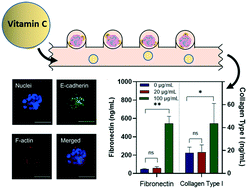Microfluidic arrays of dermal spheroids: a screening platform for active ingredients of skincare products†
Abstract
Organotypic micrometre-size 3D aggregates of skin cells (multicellular spheroids) have emerged as a promising in vitro model that can be utilized as an alternative of animal models to test active ingredients (AIs) of skincare products; however, a reliable dermal spheroid-based microfluidic (MF) model with a goal of in vitro AI screening is yet to be developed. Here, we report a MF platform for the growth of massive arrays of dermal fibroblast spheroids (DFSs) in a biomimetic hydrogel under close-to-physiological flow conditions and with the capability of screening AIs for skincare products. The DFSs formed after two days of on-chip culture and, in a case study, were used in a time-efficient manner for screening the effect of vitamin C on the synthesis of collagen type I and fibronectin. The computational simulation showed that the uptake of vitamin C was dominated by the advection flux. The results of screening the benchmark AI, vitamin C, proved that DFSs can serve as a reliable in vitro dermal model. The proposed DFS-based MF platform offers a high screening capacity for AIs of skincare products, as well as drug discovery and development in dermatology.



 Please wait while we load your content...
Please wait while we load your content...